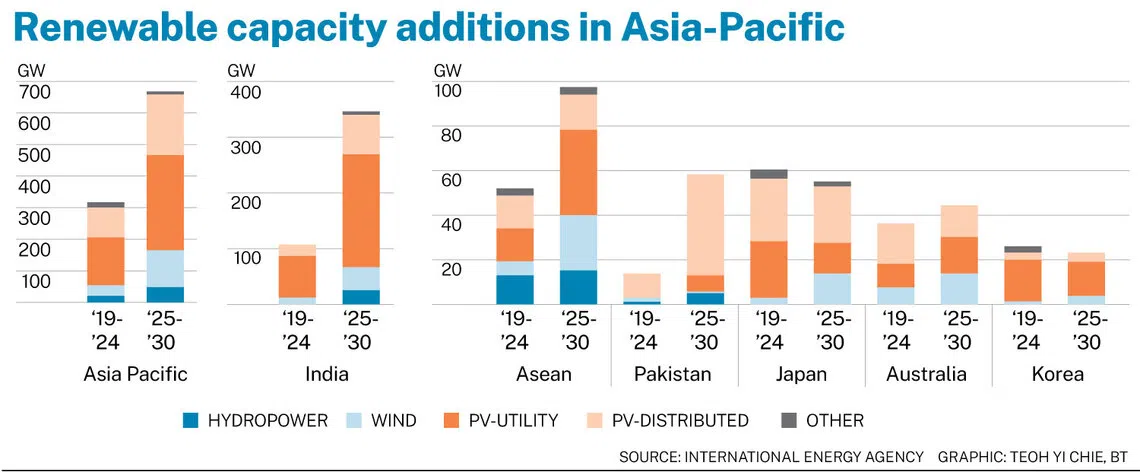Renewable capacity in Asia-Pacific ex-China to almost double over next 5 years: IEA
International Energy Agency notes in a recent report that the growth will be led by India, followed by South-east Asia

[SINGAPORE] The capacity of renewable energy in Asia-Pacific, excluding China, is expected to expand by 670 Gigawatts (GW) between 2025 and 2030 – almost doubling over the next five years.
The region accounts for the second-largest increase in global renewables growth, second only to China, indicated a recent report by the International Energy Agency (IEA).
Within the region itself, India accounts for half of the expected growth, followed by South-east Asian countries, which is projected to make up 15 per cent of that increase.
The forecast for this region has been revised upwards by almost 10 per cent from last year, reflecting improved policy and market conditions in India, Vietnam and Pakistan.
Continued auctions in the Philippines and corporate power purchase agreements in Vietnam also contributed to the more optimistic forecast.
These positive developments offset downward revisions in Japan, South Korea and Indonesia, said the report.
It also noted several persistent challenges. In some countries which have fossil fuel overcapacity and ambitious long-term decarbonisation goals, it is still costly for utilities to install new renewable energy technologies in the place of young fossil fuel-fired power fleets established on long-term contracts with take-or-pay clauses for power offtake and fuel supply.
“Renewable energy technology costs in many of these markets still exceed international benchmarks, making them less competitive. Financing costs and project risks are high,” noted the report.
Solar photovoltaic systems are expected to account for nearly 75 per cent of total renewable capacity additions in the region, with utility-scale projects making up most of the growth.
SEE ALSO
The region is also projected to be the second-largest hydropower market over the next five years, largely because of accelerated commissioning of both conventional and pumped-storage hydropower projects in India.
India is forecast to add close to 345 GW of renewable electricity capacity between 2025 and 2030, more than tripling its 2022 level.
Capacity growth is spurred largely by auctions conducted by the central government, state authorities and utility companies.
In the Asean region, more than 95 GW of renewable energy capacity is expected to be added between 2025 and 2030 – nearly double the deployment of the previous six-year period.
More than half of these additions will come from solar photovoltaic systems. Vietnam is the region’s leader, accounting for more than 40 per cent of total growth, followed by Indonesia at 20 per cent. Both countries are anticipated to accelerate capacity expansion significantly towards 2030.
“Overall, the combination of more ambitious policy targets, strengthened implementation frameworks and increased adoption of grid flexibility solutions could enable renewable deployment in Asean to reach 70 per cent above (a scenario where existing and planned policies are implemented) – the highest upside potential of all major regions,” said the report.

Global renewable energy growth
Across the globe, IEA expects 2025 to be another record year for renewables, with capacity additions to reach more than 750 GW by the end of the year, overtaking 2024 – which was a record year with renewables capacity growing 22 per cent to reach nearly 685 GW.
Solar photovoltaic systems continue to make up the majority of growth, with annual additions expanding further in 2025, though at a slower rate.
This is expected to account for nearly 80 per cent of the total global renewable electricity capacity increase, maintaining its dominant share from 2024.
Even though additional capacity from wind farms remained stable last year, IEA expects it to increase to between 139 and 155 GW this year, accounting for 18 per cent of total forecast growth.
Hydropower growth is expected to be 5 per cent slower this year, after doubling capacity in 2024. Installations in 2025 are expected to be between 23 and 24 GW, mainly from the commissioning of large projects in China and India.
While 2025 is likely to be another record year for renewable energy growth, IEA has lowered its growth forecast by 5 per cent for the period between 2025 and 2030 due to policy changes in China and the United States. It expects 248 GW less renewable capacity to be commissioned over the five-year period.
Based on the scenario that governments implement their existing and planned policies, IEA expects renewable capacity to reach 9,530 GW in 2030, a 2.6 times increase from 2022. This falls behind the target to treble renewable energy sources to 11,500 GW by 2030 that was set in 2023 during the United Nations climate change conference in Dubai.
This indicates that “an ambition gap and implementation challenges continue to impede faster renewable power expansion”, said the report.
Nonetheless, IEA expects renewables to surpass coal by the end of 2025, or by mid-2026, to become the largest source of electricity generation globally.
Another recent report from energy think tank Ember was more positive on the growth of renewables.
The report stated that solar and wind met and exceeded all demand growth in the first half of 2025, leading to renewables overtaking coal for the first time and fossil generation falling slightly.
Renewables overtook coal in the electricity mix for the first time on record, rising by 7.7 per cent to 5,720 terawatt-hour (TWh) in the first half of 2025. Its share increased to 34.2 per cent, up from 32.7 per cent in the same period last year.
Meantime, coal fell by 0.6 per cent to 4,895 TWh, with its share dropping to 33.1 per cent, down from 34.2 per cent over the same period.
Decoding Asia newsletter: your guide to navigating Asia in a new global order. Sign up here to get Decoding Asia newsletter. Delivered to your inbox. Free.
Copyright SPH Media. All rights reserved.






